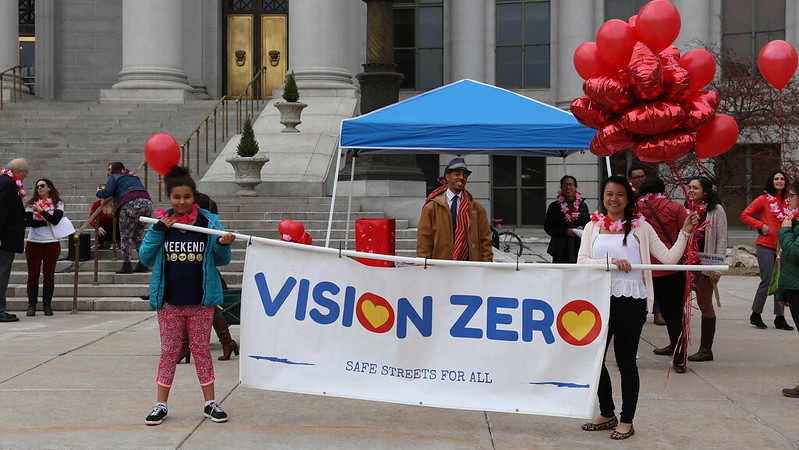Vision Zero
We advocate so that no one dies or suffers serious injuries just trying to get around Denver. Traffic deaths are preventable and unacceptable.
Read our blog post, How Denver can meet the moment with Vision Zero and view pictures from our 2023 World Day of Remembrance vigil and ceremony.

What is Vision Zero?
Vision Zero is a strategy for eliminating traffic fatalities through a systems approach, rather than placing all the responsibility on individuals to keep themselves safe. People will sometimes make mistakes, so our streets and related policies should be designed to ensure those inevitable mistakes do not result in tragedy. Read Denver’s recently updated Vision Zero Action Action Plan to learn more.
Why does it matter?
Traffic fatalities are one of the leading causes of preventable death in the U.S., along with gun violence and drug overdoses. Fatalities are going up in Denver and across the U.S., reaching a recent high of more than 80 deaths per year on our city streets. Pedestrian deaths are increasing at the fastest rate, and people of color and those living in lower-income areas are the most likely to be killed while walking.
What’s the problem, and what can be done?
The reasons why traffic deaths are going up are pretty clear: There are too many cars and trucks that are too heavy and tall, driving too fast on streets that are too wide, with too many points of conflict. Click on the links below to learn more about each of these problems, and the solutions we can pursue to make our streets safer for everyone.
Too many cars and trucks
Ninety-nine percent of fatal crashes in Denver involve a person driving a motor vehicle. Simply put, driving around in personal vehicles that weigh thousands of pounds and travel at high rates of speed is the most dangerous way for people to move through urban areas. The fewer cars and trucks that are on our city streets, the fewer opportunities there are for crashes that result in serious injuries or fatalities.
Solution: Investments in transit
A key theme of Denver’s recently updated Vision Zero Action Plan is “Focus on shifting modes away from driving by building out the transit network.” Read more about the potential for transit investments to dramatically increase safety on our city streets in our 2022 Vision Zero Call to Action: The Way to Zero Traffic Deaths is on the Bus.
Cars and trucks are too heavy and too tall
More than 80% of US car sales are now trucks and SUVs, and these vehicles keep getting bigger. For example, the Ford F-150 is now about 800 pounds heavier and 7 inches taller than it was in 1991. Electric vehicles often weigh even more due to huge batteries. These taller, heavier vehicles are much more lethal for pedestrians. Tall vehicles have bigger blind spots and are more likely to strike a person’s torso or head. Heavier vehicles exert more force crashing into a person, bicycle, or smaller car. They also have longer braking distances.
Solution: Weight-based fees and stronger regulations on vehicle design
We join with advocates across the country in calling on the Federal government to update vehicle design and safety standards to protect people on foot, on bikes, and using mobility devices from the increasing threat of large vehicles. We also support proposed state legislation that would increase registration fees for larger vehicles and use the revenues to fund safety improvements for people walking, biking, and other vulnerable road users.
Cars and trucks are too fast
Speed is a primary factor that determines whether a traffic crash happens, and whether the crash results in a serious injury or fatality: the likelihood of death increases dramatically when vehicle speeds exceed 20 mph. Higher speeds increase a driver’s reaction time and braking distance, and reduce the driver’s field of vision.
Solution: Safe street designs and lower speed limits, paired with equitable automated enforcement
The best way to reinforce safe speeds is through street design, which is why we advocated for the adoption of Denver’s new Complete Streets Design Guidelines, which includes a whole new suite of “traffic calming” treatments that help reduce speeds such as speed humps and mini traffic circles, and we are pushing for widespread implementation of these designs throughout the city. We also successfully advocated for Denver to reduce the default speed limit, which applies primarily to neighborhood streets, from 25 to 20 mph, and are pushing for speed limit reductions on other streets as well. These lower limits further justify implementation of traffic calming treatments. Finally, we are calling on the City to increase the equitable use of automated speed enforcement, another proven strategy for reducing speeding and crashes.
Streets are too wide, with too many points of conflict
Decades of planning our streets to cater to the efficient and rapid movement of cars, trucks, and other motorized vehicles has negatively impacted the ability to travel safely through our city. Many of the most dangerous streets in our city, like Colfax Avenue and Federal Boulevard, are designed like highways, often six or more lanes wide. These wide streets encourage high vehicular speeds, and the lack of basic accommodations for people walking, rolling, biking, and accessing transit creates dangerous conflicts among road users.
Solution: Transformation of urban arterials from deadly highways to people-friendly main streets
Denver’s highway-style urban arterials are currently the most dangerous streets in our city, and are also home to many of the destinations that Denverites are trying to reach every day, including a plethora of cherished, locally owned businesses that reflect the rich cultural diversity of the surrounding neighborhoods. To achieve their full potential as people-friendly main streets and be truly safe for everyone, these corridors must be fundamentally transformed. This means reducing the number and width of vehicular travel lanes, and adding dedicated space for sidewalks, bike lanes, and transit so that more people can get around more easily without driving. Read more about how transit is at the heart of this needed transformation in our 2022 Vision Zero Call to Action: The Way to Zero Traffic Deaths is on the Bus.
Policy Wins for Vision Zero
- January 2023: Denver City Council votes to decriminalize jaywalking, acknowledging the reality that “jaywalking” is what people often have to do to navigate car-centric communities and that the criminalization of jaywalking has led to racist and discriminatory enforcement. Learn more about the Freedom to Walk and Roll: Denverite, Westword, Denver Post
- December 2021: Denver City Council passes an ordinance reducing neighborhood speed limits from 25 miles per hour to 20 miles per hour. The likelihood of serious injury or a fatality in a traffic crash increases the faster a vehicle is moving, and lowering the speed limits on neighborhood streets helps keep everyone safe. Learn more about 20 Is Plenty.

Cole’s Story
On July 13, 2016, Cole Sukle and his two best buddies were enjoying a sunny summer day, riding skateboards through their neighborhood, when they stopped to cross Yale Boulevard on their way to the middle school basketball court nearby. Standing safely within the bike lane, one of the boys looked to his left, barely processing the speeding car already upon them and too late to do anything more than jump back. The boy watched helplessly as the speeding drunk driver hit his two friends and drove away. Miraculously, two of the boys escaped the crash unharmed, but Cole was rushed to Denver Health where he died the next day.
When the City of Denver asked Cole’s family if they’d be willing to share his story as part of the announcement of a new plan to eliminate traffic fatalities in Denver, they were honored to oblige. Like most people, the Sukles didn’t know much about what made streets safe or unsafe. They taught their kids to look both ways, stay on the sidewalk and always use the crosswalk. But the Vision Zero Action Plan that Cole’s story helped announce opened their eyes to the ways cities can either design streets and neighborhoods to be safe for people walking and biking, or cater to cars, leaving streets deadly and dangerous.
Cole’s story is just one of hundreds that inspires the Denver Streets Partnership to consistently hold the City accountable to its commitment to eliminate traffic fatalities and serious injuries by the year 2030.
Related Resources
Agenda for the new Mayor and City Council’s first 100 days in office
The Denver Streets Partnership has released an agenda for Mayor-Elect Johnson and the Denver City Council’s first 100 days in office. The full agenda includes five high-priority actions that can be taken quickly to help address traffic safety, access, and the transportation sector’s impact on climate change and air pollution: Appoint a capable and visionary Director […]
Agenda for the new Mayor and City Council’s first 100 days in office
The Denver Streets Partnership has released an agenda for Mayor-Elect Johnson and the Denver City Council’s first 100 days in office. The full agenda includes five high-priority actions that can be taken quickly to help address traffic safety, access, and the transportation sector’s impact on climate change and air pollution: Appoint a capable and […]
Denver residents seek renewed focus on ending traffic deaths: ‘Lives are at stake’
Since Mayor Michael Hancock committed to eliminating traffic deaths seven years ago, Denver’s roads have only gotten deadlier. As Mayor-elect Mike Johnston prepares to take the city’s reins, Denverites are asking for change.
Michael Hancock gave Denver a bold ‘Vision Zero’ goal of eliminating traffic deaths. Here’s why it failed
In the six full years since the city committed to Vision Zero, more than 400 people have died in traffic, and there’ve been more than 2,000 crashes causing serious injuries.
Mother of cyclist killed in collision wants Denver to do more to make streets safer
Wednesday the City recommitted to Vision Zero but Thursday critics and Cindy Stepp gathered on the corner where Ainslie was killed to say it isn’t enough.
Her daughter was killed on her bike in Denver. She’s still riding and pushing leaders to make streets safer
Advocates for street safety, including Stepp, spoke at the site of Ainslie O’Neil’s death Thursday to pressure Denver’s current and future city leaders to do more.
Denver Streets Partnership urges city to prioritize funding for updated Vision Zero plan
As traffic fatalities in Denver continue to be a growing issue, the city announced Wednesday that it is recommitting to its 2017 Vision Zero plan that aims to eliminate traffic deaths by 2030.
Denver’s Vision Zero pledge is failing. The city’s reset calls for slower speeds to stop deaths
Mayor Michael Hancock is recommitting to its “Vision Zero” program that reframes serious and fatal crashes as systemic problems that need infrastructure or engineering fixes. His administration on Wednesday released an updated plan that he hopes will get the city back on track.
Federal Boulevard site of multiple hit-and-run crashes
Federal Boulevard has seen multiple hit-and-run crashes in recent days. A reward is being offered. On Feb. 22, a pedestrian was hit crossing South Federal Boulevard at West Dartmouth Avenue. The injuries are considered serious. Denver Police say the driver left the scene.
Denver’s getting money to study nine dangerous roadways as it tries to achieve Vision Zero’s goals
Denver and Vision Zero, the city’s initiative to completely eradicate traffic deaths and serious injuries by 2030, is receiving some funding to help further the mission.
Wins & Wrecks for Vision Zero
We’re kicking off the year sharing a round-up of what we consider Wins & Wrecks for the U.S. Vision Zero movement. This is not intended to be an exhaustive list, but rather a cross-section of bright spots – some that are already yielding positive results and some that we’re optimistically projecting will do so – and some disappointments, or shall we say, opportunities to do better.
